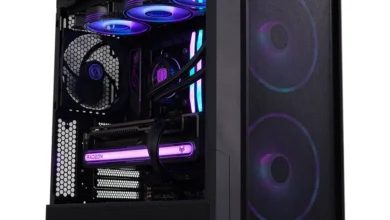Gaming PC Build for Beginners: A Comprehensive Guide

Building your own gaming PC is an exciting and rewarding experience. Not only does it allow you to tailor your system to your specific needs, but it can also save you money while providing a sense of accomplishment. In this article, we’ll walk you through a Gaming PC build for beginners, covering every component you need, tips for assembling your rig, and addressing common FAQs to make the process as smooth as possible. Whether you’re completely new to PC building or simply need a refresher, this guide is for you.
Why Build Your Own Gaming PC?
Before diving into the details of a Gaming PC build for beginners, let’s explore why you should consider building your own system:
- Customization: Choose parts that suit your needs, whether for high-end gaming, streaming, or casual play.
- Cost Efficiency: Building your own system often saves money compared to pre-built PCs.
- Upgradeability: A custom build allows for easier upgrades in the future.
- Learning Experience: The process helps you understand how a computer works, which is useful for troubleshooting and maintenance.
Essential Components for a Gaming PC Build for Beginners
1. Central Processing Unit (CPU)

The CPU is the brain of your computer. Popular beginner-friendly CPUs include:
- AMD Ryzen 5 5600X: Great performance for gaming and multitasking.
- Intel Core i5-12400F: Budget-friendly with strong single-core performance.
2. Graphics Processing Unit (GPU)
The GPU handles rendering for games. Entry-level options:
- NVIDIA GeForce GTX 1660 Super: Reliable for 1080p gaming.
- AMD Radeon RX 6500 XT: Affordable and efficient.
3. Motherboard
Ensure compatibility with your CPU and future-proofing.
- MSI B550-A PRO (for AMD CPUs)
- ASUS Prime B660M-A (for Intel CPUs)
4. Memory (RAM)
At least 16GB of DDR4 RAM is recommended for gaming.
- Corsair Vengeance LPX 16GB (2 x 8GB) DDR4 3200MHz
5. Storage
For fast load times and plenty of space:
- SSD: Samsung 970 EVO Plus 500GB for your operating system and games.
- HDD: Seagate Barracuda 1TB for extra storage.
6. Power Supply Unit (PSU)
Choose a reliable PSU with sufficient wattage.
- Corsair CX550M (550W, semi-modular)
- EVGA 600 BR (600W, budget-friendly)
7. Case
Pick a case that suits your style and fits all your components.
- NZXT H510: Sleek and beginner-friendly.
- Cooler Master MasterBox Q300L: Compact and affordable.
8. Cooling System
Most CPUs come with stock coolers, but consider aftermarket options for better performance.
- Cooler Master Hyper 212: Affordable and effective.
9. Operating System (OS)
Install a reliable OS for gaming:
- Windows 11: Widely compatible and optimized for gaming.
- Linux (e.g., Ubuntu or Pop!_OS): Free and open-source but with limited game compatibility.
Suggested Build for Beginners
| Component | Model | Approximate Cost |
|---|---|---|
| CPU | AMD Ryzen 5 5600X | $180 |
| GPU | NVIDIA GTX 1660 Super | $220 |
| Motherboard | MSI B550-A PRO | $120 |
| RAM | Corsair Vengeance 16GB DDR4 | $60 |
| Storage (SSD + HDD) | Samsung 970 EVO + Seagate 1TB | $150 |
| PSU | Corsair CX550M | $70 |
| Case | NZXT H510 | $70 |
| Cooling | Stock cooler | Included |
| Total Cost | $870 |
Step-by-Step Assembly Guide
- Prepare Your Workspace:
Ensure a clean, static-free area with all tools ready (screwdriver, zip ties, thermal paste if needed). - Install the CPU and Cooler:
Place the CPU in the motherboard socket and secure the cooler. - Install RAM:
Insert the RAM sticks into the appropriate DIMM slots. - Attach the Motherboard to the Case:
Screw the motherboard onto the case’s standoffs. - Install Storage Drives:
Secure your SSD and HDD in their respective bays. - Add the GPU:
Slot the GPU into the PCIe slot and secure it with screws. - Connect the PSU:
Attach all necessary power cables (24-pin for the motherboard, 8-pin for the CPU, etc.). - Cable Management:
Use zip ties to tidy up cables and improve airflow. - Install the OS:
Use a bootable USB to install your operating system.
FAQs About Gaming PC Build for Beginners
1. Is building a gaming PC hard?
Not at all! A Gaming PC build for beginners is straightforward if you follow guides and videos. Patience and attention to detail are key.
2. How much should I spend on a beginner gaming PC?
A good entry-level gaming PC typically costs between $800 and $1,200, depending on your needs and available deals.
3. Can I use my old PC parts?
Yes, as long as they are compatible. For example, an old PSU or case can often be reused.
4. What games can I play with this setup?
This beginner build can handle popular titles like Fortnite, Apex Legends, and Cyberpunk 2077 at 1080p with medium to high settings.
5. How long will this PC last before I need an upgrade?
With proper care and minor upgrades, a Gaming PC build for beginners can last 5-7 years.
6. Do I need extra cooling?
Stock coolers are sufficient for most beginner builds. Upgrade if you plan to overclock.
7. Is Windows the only gaming OS?
While Windows is the most compatible, Linux is an option for those who prefer open-source software.
8. Should I overclock my system?
Overclocking can boost performance but is not necessary for a beginner gaming PC build.
Conclusion
A Gaming PC build for beginners is an exciting project that provides long-term benefits, from cost savings to enhanced gaming performance. By selecting the right components, following a clear assembly process, and addressing common concerns, you’ll be gaming in no time. Whether you aim to build a budget-friendly system or a slightly more powerful rig, the key is to start with a solid foundation. Happy building!






One Comment